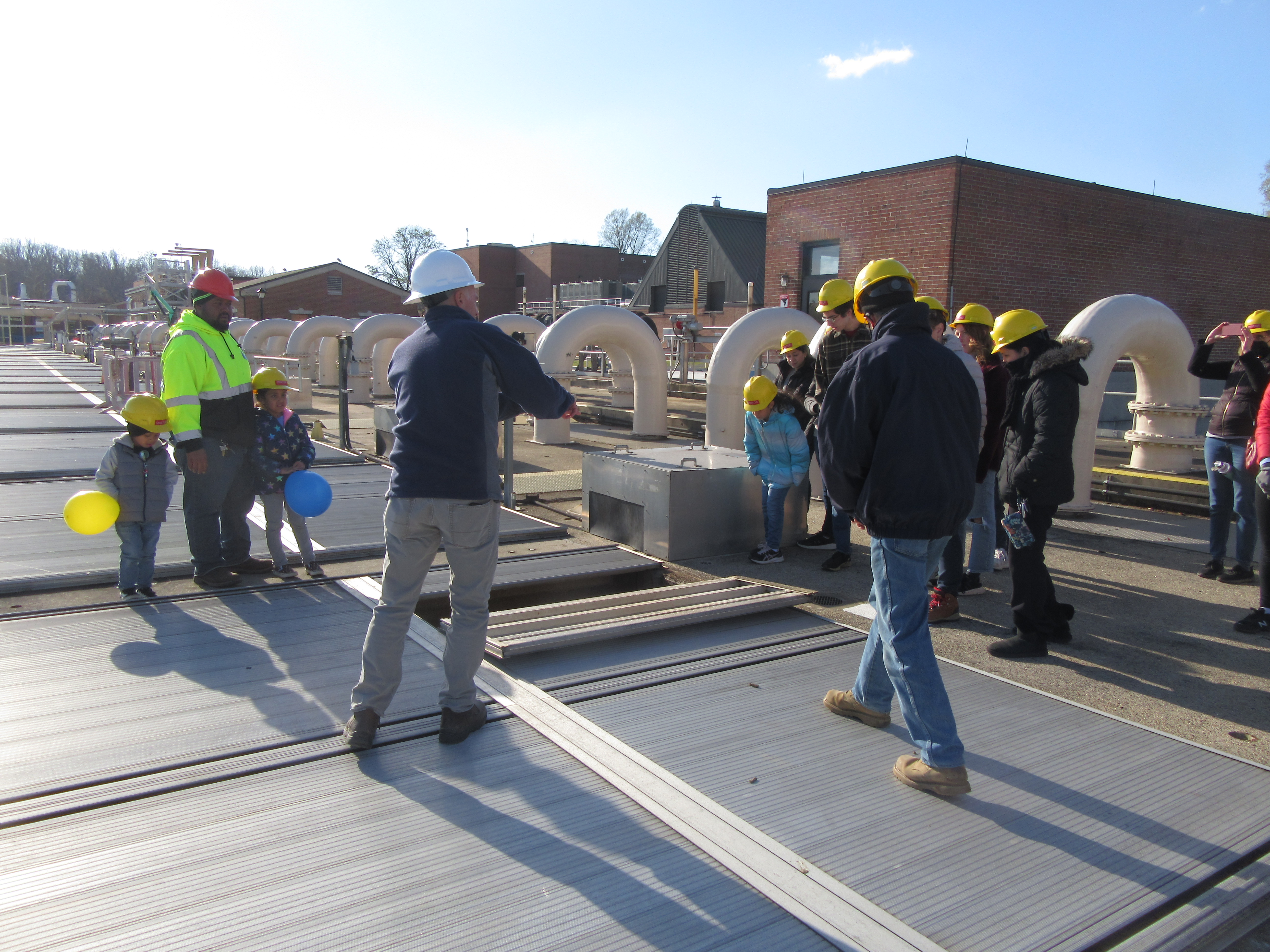Wednesday, November 30, 2022
But it’s not really gone. The water and everything it carries along with it travel through underground pipes to a wastewater treatment facility, commonly called “the sewage plant.”
Fairfax County, a 407-square-mile jurisdiction with 1.1 million people who flush, bathe, clean, wash and water lawns, has 3,380 miles of sanitary sewer infrastructure, including 63 pumping stations that move wastewater to five treatment plants.
On Nov. 19, officials with the county’s Noman Cole Pollution Control Plant at 9399 Richmond Highway in Lorton conducted a public tour of the facility’s 360 acres of grounds, buildings, streets, pipes, pumps, holding tanks, deodorizers, disinfectors, ponds and control room. They explained the five steps that clean the water before
 McGrath explains the stages of wastewater treatment as visitors peered into tanks
McGrath explains the stages of wastewater treatment as visitors peered into tanks
The Noman Cole plant is the only plant the county owns. Built in the 1970s, it was originally designed to handle 18 million gallons a day. Today, every day, it treats 40 million gallons, equivalent to 60 Olympic swimming pools, and can treat up to 67 million gallons for its 300,000 customers. This translates into more than 420 million gallons of wastewater a year, explained Mike McGrath, the county’s Director of Wastewater Treatment. These numbers represent 40 percent of the county’s total wastewater flow or volume.
The Cole facility has more than 7,000 “major assets,” said McGrath. The instrumentation and control system has more than 20,000 “tags.” Each tag is a signal that is collected, usually multiple times a minute. Instruments and equipment may have multiple tags. The plant operates 24 hours every day and has five backup generators for power outages.
These statistics are mind-numbing numbers, but explicit indicators of an engineering marvel that most residents take for granted. From the dirty wastewater that enters the plant, called influent, to the cleaner water that leaves, effluent, wastewater treatment is a complicated process involving biology, chemistry, engineering, technology and human expertise.
McGrath literally and verbally walked the group through wastewater treatment stages, including what experts call “preliminary, primary, secondary and tertiary treatment.” On average, depending on the distance, it takes up to five hours for a drop to water to get to the Noman Cole plant. One drop that comes in leaves the plant cleaner in about 22 hours.
Raw sewage coming in is mostly water and carries items like plastics, sticks, rags, rocks, socks and even dead animals. Mechanical screens remove these objects and pumps whoosh the wastewater to clarification tanks where solid matter settles (sludge) or floats (scum).
At another stage, biological and physical methods consume and remove organic matter. The plant grows 20 tons of microbes a day to treat wastewater. Microorganisms can reduce nitrogen levels and clarifiers help remove phosphorus. A disinfection process uses ultraviolet light to kill 99 percent of the pathogens.
Visitors got a mild olfactory hit a few times – clearly not chocolate -- and McGrath offered, “We invested over $20 million to keep the odors down.” Pointing to the bio-tower, he said, “It has enormous sponges to remove odors.”
The plant removes 90 percent of pollutants, McGrath noted, like pathogens. “Without adequate sewage collection and treatment, more citizens would get sick from waterborne diseases and our county’s streams would be more polluted. Before the implementation of reliable drinking water and wastewater treatment, thousands of people in the United States died of waterborne diseases like cholera, dysentery, typhoid, polio and hepatitis.” Decaying organics rob the water column of oxygen and suffocate fish. Solids silt up streams.
Wastewater plants in the Chesapeake Bay region target nitrogen and phosphorus for reduction. Nitrogen and phosphorus can stimulate excessive algae which block sunlight needed by submerged aquatic vegetation (SAV). SAV beds help improve water quality and serve as fish nurseries.
Everyday, two full dump trucks haul solids in the form of ash to the I-95/Lorton landfill, the material removed from the incoming wastewater.
Plant employees conduct 25,000 tests a year to meet Clean Water Act and other requirements. For 30 years, George Mason University scientists have monitored the outgoing water at Gunston Cove and found improvements in recent years. While the discharged water is much cleaner going out than coming in, it is not potable for humans.
Julia Christ, an eleventh grader is studying the nitrogen cycle at West Springfield High School and wanted to learn more. Mount Vernonite Greg Crider remarked, “I was curious about how wastewater is treated. I’m impressed.”
McGrath applauds the plant’s staff. “Every hour of the year, the 130 or so employees at the Noman Cole plant are protecting public health and improving the environment by reclaiming clean water from sewage. Readers Digest readers rank it as the second most important job in the United States.”
Pointing to a pipe crammed with grayish-brown, compacted detritus removed from the wastewater, McGrath told the group, “Every month or so we get calls asking if we’ve found a diamond ring.” And while he’s proud of the plant’s operations, he said with a laugh, “No, no diamond rings.”
No-no’s
Exhibits explained how to prevent backups and overflows. The drain lines from homes to the county’s sewer system are only big enough to carry water, toilet paper and human waste. Here are the most common, problematic “unflushables.”
* Wipes, even those labeled “flushable”
* Cotton balls and swabs, feminine hygiene products, dental floss, paper towels
* Fats, oils and grease, including oils and grease from cooking
* Medications
Information
Tutorial on the wastewater treatment process, U.S. Geological Survey, https://www.usgs.gov/special-topics/water-science-school/science/visit-wastewater-treatment-plant
Fairfax County treatment plant service areas, https://www.fairfaxcounty.gov/publicworks/wastewater/wastewater-treatment